Doak Campbell Stadium
Doak S. Campbell Stadium (in full Bobby Bowden Field at Doak S. Campbell Stadium), popularly known as "Doak", is a football stadium on the campus of Florida State University in Tallahassee, Florida. It is the home field of the Florida State Seminoles football team of the Atlantic Coast Conference (ACC).
"The House That Bobby Built" | |
 The entrance to the stadium | |
 Doak Campbell Stadium Location in Florida  Doak Campbell Stadium Location in the United States | |
| Location | 403 Stadium Drive West, Tallahassee, FL 32306 |
|---|---|
| Coordinates | 30°26′17″N 84°18′16″W |
| Owner | Florida State University |
| Operator | Florida State Athletics |
| Capacity | 15,000 (1950–1953) 19,000 (1954–1960) 25,000 (1961–1963) 40,500 (1964–1977) 47,413 (1978–1979) 51,094 (1980–1981) 55,246 (1982–1984) 60,519 (1985–1991) 70,123 (1992) 72,589 (1993) 75,000 (1994) 77,500 (1995) 80,000 (1996–2000) 82,000 (2001–2002) 82,300 (2003–2015) 79,560 (2016–present)[1] |
| Record attendance | 84,431 (October 18, 2014) |
| Surface | 419 Tifway Bermuda Grass[2] |
| Construction | |
| Broke ground | June 1950 |
| Opened | October 7, 1950 |
| Expanded | 1954, 1961, 1964, 1977, 1980, 1982, 1985, 1992–1996, 2001, 2003, 2016 |
| Construction cost | $250,000 (in 1950) ($2.66 million in 2019 dollars[3]) |
| Architect | Ball-Horton & Associates[4] Barnett Fronczak Architects The Architects Collaborative (Renovations) |
| General contractor | Jack Culpepper Construction Co.[5] |
| Tenants | |
| Florida State Seminoles football (NCAA FBS) | |
Opened in 1950, it was originally named Doak Campbell Stadium in honor of Doak S. Campbell, the university's president from 1941 to 1957. On November 20, 2004, the Florida Legislature added longtime head football coach Bobby Bowden to the stadium name to become Bobby Bowden Field at Doak Campbell Stadium.[6] A petition in June 2020 sought to remove Campbell's name, because he allegedly resisted racial integration while he served as President of Florida State University.[7][8]
The stadium is part of the University Center complex, a mixed-use facility encompassing university office space, university classrooms, the university's Visitor's Center, souvenir store, The University Center Club, and skyboxes and press boxes for use during football games.
With a stadium capacity of 79,560, it is the largest continuous brick structure in the United States, the second-largest stadium in the Atlantic Coast Conference, and the 18th largest stadium in the NCAA.[9]
History
.jpg)
The stadium, named after FSU President Doak Campbell, hosted its first game against the Randolph-Macon College Yellow Jackets on October 7, 1950 with the Seminoles winning the game 40–7. At that time the facility had a seating capacity of 15,000. Florida State began to play at Centennial Field during the team's 1947 season and would continue to play there for the following two years (1948 and 1949). Florida State College – FSU's predecessor institution – also fielded teams from 1902–1904 (precise location of where games were played is not documented). Doak Campbell Stadium, with its original capacity of 15,000 in 1950, was built at a cost of $250,000. In 1954, the stadium grew to a capacity of 19,000. Six thousand more seats were added in 1961. During the Bill Peterson era (1960–70), the stadium was expanded to 40,500 seats, and it remained at that capacity for the next 14 years.
Since that time, the stadium has expanded to 82,300, largely in part to the success of the football team under head coach Bobby Bowden coupled with the ever-growing student body. It now is the 2nd largest football stadium in the Atlantic Coast Conference (ACC). Aesthetically, a brick facade surrounding the stadium matches the architectural design of most of the buildings on the university's campus. In addition to the obvious recreational uses, The University Center surrounds the stadium and houses many of the university's offices. The field was officially named Bobby Bowden field on November 20, 2004 as Florida State hosted intrastate rival Florida.[6] The FSU War Chant began during the Auburn game in 1983 and has since spread to be used by fans of the Atlanta Braves and Kansas City Chiefs.[10]
Expansion and improvements

Following the latest expansion in 2003, the stadium has a seating capacity of 82,300. Prior to the start of the 2007 season, a new state-of-the-art sound and public address system was installed. Before the 2008 season, two new HD Scoreboards were installed; the main one in the north endzone measures over 100 ft (30 m), the south endzone has a 45-foot (14 m) scoreboard. Six new LED ribbon boards were installed in each of the four corners of the stadium as well as underneath the north scoreboard, over the player entrance and above the entrance used by the Marching Chiefs. The new boards allow for more game stats and more information on other games in addition to improved replay viewing. An indoor practice facility, adjacent to the stadium, was constructed in 2013.

Champions Campaign
In 2015, construction began on an $85 million project to completely renovate Doak Campbell Stadium. This project is part of the bigger $250 million Florida State Seminoles Champions Campaign to improve all aspects of athletics at Florida State University. The Doak Campbell Stadium renovation project included adding a new premium outdoor seating section, making structural repairs, repainting the stadium and updating sky box suites.
All construction was completed by August 2016 and opened in September, prior to the 2016 season.[11]
Largest attendance
| Rank | Date | Attendance | Opponent | FSU Result |
|---|---|---|---|---|
| 1 | October 18, 2014 | 84,431 | #5 Notre Dame | W, 31-27 |
| 2 | November 2, 2013 | 84,409 | #7 Miami | W, 41–14 |
| 3 | September 17, 2011 | 84,392 | #1 Oklahoma | L, 13–23 |
| 4 | September 5, 2005 | 84,347 | #9 Miami | W, 10–7 |
| 5 | October 11, 2003 | 84,336 | #9 Miami | L, 14–22 |
| 6 | November 20, 2004 | 84,223 | Florida | L, 13–20 |
| 7 | October 16, 2004 | 84,155 | #6 Virginia | W, 36–3 |
| 8 | October 26, 2002 | 84,106 | #12 Notre Dame | L, 24–34 |
| 9 | November 30, 2002 | 83,938 | #15 Florida | W, 31–14 |
| 10 | November 5, 2005 | 83,912 | NC State | L, 15–20 |
Statues and stained glass
Unconquered

A 19-foot (5.8 m) tall bronze sculpture by Fritz White depicting Osceola and Renegade. A tradition was immediately put in place whereby at sunset, on the night before home football games, as the Marching Chiefs play, Osceola's spear is set aflame as students, alumni, and fans gather around the statue to show their support. The flame is later extinguished at sunrise on the morning following the game. As of March, 2006, the university decided to light the spear for several reasons, including: selection into the NCAA basketball tournament, "National Player of the Year" awards for any sport, conference championships, graduations and convocations, etc.[12] A small inscription near the base of the statue reads: "This statue does not depict any particular person or event. Rather, it symbolically portrays the unconquered spirit of the Seminole people of the 19th century and the timeless legacy of that spirit that continues to burn bright into the future." The statue was unveiled at the Williams Family Plaza on October 10, 2003, and "Unconquered" was engraved in its stone pedestal on September 2, 2005.
Sportsmanship
A bronze sculpture by Edward Jonas, is a 15-foot (4.6 m) tall statue depicting a standing football player extending his arm to help pick up a fallen rival on the field. In 2002 the statue was selected by the National Sculpture Society to be showcased in its special exhibit "Sports Sculpture." A one-quarter life size scale model represented the sculpture in the New York City exhibition. The statue is located at the Al D. Strum Plaza.
Bobby Bowden sculpture
A 9-foot (2.7 m) tall bronze statue of head football coach Bobby Bowden, created by W. Stanley "Sandy" Proctor, was unveiled outside of the Coyle E. Moore Athletic Center on September 25, 2004 and was dedicated along with the Les and Ruth Akers Plaza.
Stained glass window
A three-story, stained-glass window commemorating the naming of the field was unveiled on November 20, 2004, the day of the annual Florida State/Florida game. The window depicts Bowden overlooking the field among a sea of fans in the stands. The 30-by-20-foot (9.1 by 6.1 m) window was installed over the entrance of the Moore Athletic Center. Created by Florida State artist Robert Bischoff, his wife, JoAnn, and 12 Florida State students in the Master Craftsman Program, the window is among the five largest stained glass windows in the United States.[6]
Seminole Family in Bronze
This new addition to the outside of the stadium was unveiled on Friday, October 20, 2006. The statue was designed by Brad Cooley, Sr. and Brad Cooley, Jr. of Lamont. Known as "Seminole Family in Bronze", the statue shows what may have been a typical Seminole family around the time of the Seminole Wars in the 1800s.[13]
University Center
Doak Campbell is a unique venue in collegiate football. It is contained within the brick facade walls of University Center, a vast complex that houses the offices of the university, the Registrar, the School of Hospitality, the College of Communications and the College of Social Work as well as numerous other offices and classrooms.
University Center A (East Wing)
Building A has two "towers" and houses the offices of the Registrar, Financial Aid, Admissions and others in one tower, and International Programs, the Dean of Students and the award-winning College of Motion Picture Arts, known commonly as the Film School, in the other. The Career Center was also located here until it is moved to the new Student Success Center. The top two floors are home to privately owned skyboxes.
University Center B (South Wing)
Building B holds the Seminole Sportshop as well as Visitor Services. UCB is also home to the University Center Club and to the Osceola Sports Grill. The highly ranked Dedman School of Hospitality is located on the second floor of Building B.
University Center C (West Wing)
Building C like Building A, has two "towers" and is home to the College of Communication and Information, Florida State Testing Center as well as the College of Social Work. The Athletics Ticket Office is also located here as are many of the offices of the Seminole Boosters. Floor nine is home to the Press Boxes with two floors of Skyboxes below.
Moore Athletic Center (University Center D)
Located on the North Side of Doak Campbell, the athletic center houses nearly all of the athletic offices as well as some classrooms and lecture halls. Visitors are welcomed into the Great Hall showcasing the best of Seminole Athletics.
Gallery
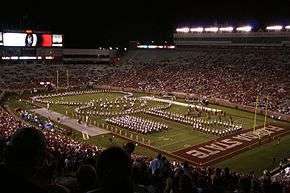 Marching Chiefs Show
Marching Chiefs Show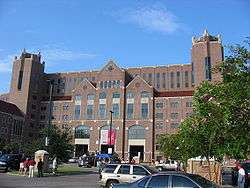 University Center
University Center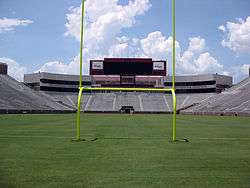 North end zone
North end zone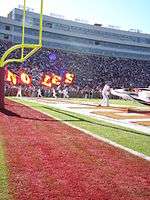 Sidelines during a game
Sidelines during a game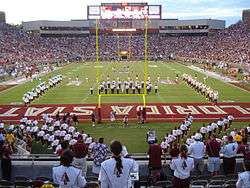 Pregame
Pregame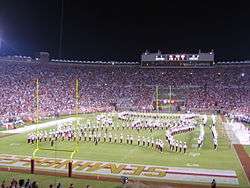 Halftime
Halftime
 The field is named after former coach Bobby Bowden
The field is named after former coach Bobby Bowden
See also
References
- "Bobby Bowden Field at Doak S. Campbell Stadium". Florida State University Athletic Department. Archived from the original on July 24, 2014. Retrieved August 13, 2016.
- "Bobby Bowden Field at Doak S. Campbell Stadium". Florida State University. 2018. Retrieved January 7, 2018.
- Federal Reserve Bank of Minneapolis. "Consumer Price Index (estimate) 1800–". Retrieved January 1, 2020.
- "Speed in Fifty-Year Plan Seen in Building Progress". Florida Flambeau. June 2, 1951. Retrieved September 3, 2012.
- Sessions, Montrell (October 6, 1950). "3-Year Old FSU Dream Realized With Stadium". Florida Flambeau. p. 2. Retrieved September 12, 2018.
- "FSU To Dedicate Window, Field In Honor Of Legendary Coach Bowden" (Press release). Atlantic Coast Conference. November 17, 2004. Archived from the original on April 4, 2012. Retrieved October 28, 2009.
- "FSU to review changing football stadium's name". ESPN.com. 2020-06-22. Retrieved 2020-06-28.
- "FSU Head is in Quandary Over How to Ban Student Support of Integration | fsu.digital.flvc.org". fsu.digital.flvc.org. Retrieved 2020-06-28.
- Dowell, Stephen M. (September 12, 2011). "FSU Football: Behind the Scenes at Doak Campbell Stadium". Orlando Sentinel. Retrieved September 12, 2018.
- "The War Chant". Florida State University Athletic Department. Archived from the original on April 15, 2012. Retrieved November 6, 2013.
- Henry, Jim (August 11, 2015). "Eyes to the Future: Doak Campbell Holds Financial Key". Tallahassee Democrat. Retrieved September 12, 2018.
- "Florida State's Expanded Spear Lighting Tradition Begins Monday Night" (Press release). Florida State University Athletic Department. March 8, 2006. Archived from the original on January 19, 2013. Retrieved October 28, 2009.
- "'Seminole Family' Statue to be Unveiled at FSU" (Press release). Florida State University. October 18, 2006. Retrieved October 28, 2009.
External links
| Wikimedia Commons has media related to Doak Campbell Stadium. |